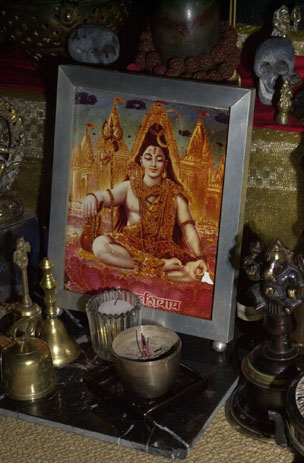|
As with other borrowings, the incorporation of Hindu
elements into the
Orisha belief system characteristically
takes different forms around the island. Worshippers
usually simply superimpose the borrowed elements onto Orisha
beliefs and practices. Typically,
one finds at an Orisha
shrine a small area devoted to one or more Hindu deities.
This area generally contains statues, statuettes, and large
poster representations of the deities
and an assortment of
Indian brass receptacles, candles, incense and other
materials.
Among the Hindu deities most commonly found in Orisha
worship are Hanuman, Mahabir, Lakshmi, and Rama. Because
virtually all the Hindu deities
borrowed by Orisha are
popular figures in many public Hindu festivals and
ceremonies in Trinidad, even the most uninterested African
will have some familiarity with them.
Hinduism also
manifests to a small degree in the form of Osain (also
referred to as Osanyin or Osa), who clearly has Yoruba
origins and can be found in Orisha compounds
all over the
island, but whose shrine is often surrounded with Hindu
religious materials. Osain, sometimes referred to as "the
Indian man," is, however, formally
syncretized with Saint
Francis (see Chapter Thirteen).
Although
Hindu-Orisha syncretism is rare, a few of the more
knowledgeable worshippers do speak of an association
between
particular Hindu deities and African orisha. The perceived
similarities of the gods of both groups allow for a
syncretism similar to the associations worshippers
have made
between the Catholic saints and orisha. Leader Scott noted
the following pairings (the Orisha are listed first):
Ogun/Mahabir (or Hanuman),
Osain/Mahadeo, Oya/Parvati,
Oshun/Lakshmi,
Mama Lata/Pahrmisar,
Shakpana/Durga,
Eshu/Dee
and Obatala/Ganesha.
Noorkumar Mahabir and Ashram Maharaj
(1989, 194) also mention
syncretisms involving Ogun and
Hanuman or Mahabir, and Oshun and Ganga
Mai.
Nevertheless, in regard to the group as a whole, the
relationship that exists between the Orisha religion and
Hinduism is not a purely syncretic one.
Only a few Orisha
worshippers, such as Leader Scott, recognize a syncretism
involving African and Hindu deities. Personal conceptions
of relationship between various
gods and spirits, involving
as they do the association between concepts and beliefs of
different religious traditions such as Catholic and African,
or Hindu and African, reflect a sophisticated
understanding
of different belief systems as being functionally equivalent
on some level.
In addition to "mainstream" Hinduism, there is another form
of Hindu worship in Trinidad which resembles Orisha worship:
the Kali-Mai ("black mother") sect
also practices ritual
possession and animal sacrifice. The Kali-Mai sect tends to
be associated with the darker-skinned Madras people, and
mainstream Hindus consider such worship
"primitive" and
"uncivilized." According to William Guinee (personal
communication) -- a folklorist who worked with Hindus in
Trinidad -- as well as Leader Scott and
many of the older
Hindus, Kali-Mai worship was village-based at one time, and
its practice was widespread. Through time the sect
gradually lost its appeal but has begun
to make something of
a comeback, although probably in altered form. For example,
a large and elaborate temple in St. Augustine, only recently
constructed by Kali-Mai worshippers,
draws two to three
hundred people every Sunday.
It is interesting
to note that although African
participation in mainstream Hinduism is virtually nil, some
7 or 8 percent of those attending Kali-Mai services are
African. It may be the strong emphasis
that the Kali-Mai
sect puts on healing that attracts the Africans. At the
four Sunday services I attended, it appeared to me that the
Indian worshippers welcomed the Africans
with an openness
that is apparently uncommon at the ceremonies of mainstream
Hinduism.
There is little or no actual association between the
Kali-Mai sect and the Orisha religion, but worshippers from
each group are supportive of or at
least sympathetic to the
religious practices of the other.
pp. 88-9
Spirit, Blood and Drums: the Orisha Religion in Trinidad
James
T. Houk
(Philadelphia: Temple University Press, 1995)
To view this article on its original page on the Lucky Mojo site, click here.
|


